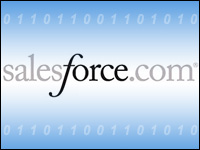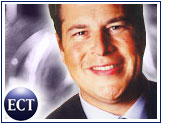
Marc Benioff, chairman and CEO of Salesforce.com, rang the closing bell at the New York Stock Exchange last Wednesday, an act that some day may be viewed as the end of the beginning of the hosted enterprise-software revolution. The ritual market closing was part of a bigger event: the company’s first presentation to the press and financial analysts since going public in June.
Benioff’s decision to list his company’s stock on the NYSE may be emblematic of many other actions taken in the five years of Salesforce.com’s brief life. It was unconventional in that most other software companies from Microsoft on down have elected to be traded over the counter. (The story goes that NYSE is saving the prestigious single letter ticker symbol “M” for the day that Microsoft follows Salesforce.com’s lead.)
But Salesforce’s decision to list with the NYSE is also very much in character. The self-proclaimed first software utility chose to be among all the other utility companies, many of which were founded in the first American industrial revolution.
Not Your Average Dog and Pony Show
Benioff was in New York along with a troop of senior executives and employees putting on a conspicuous display of success for the people who make the markets. In a slow summer that has seen any number of technology — and especially software — companies warn analysts about soft earnings, Salesforce.com was explaining its radically different technology and its equally distinctive subscription-based revenue model, which is far more predictable than what the financial analysts had become accustomed to over decades of ups and downs in the enterprise software market.
Unable to absorb the good news, Wall Street suffered a brain cramp, and Salesforce’s stock sank 4 points on the day. Undeterred, CRM’s price rebounded well the next day.
There was a serious message embedded in the presentations, the panel discussion with major customers, the Q&A with management, and the reception in those very corporate surroundings. Hosting is not different for the sake of difference; the software industry is changing in fundamental ways. The proof point has been made, and its success has brought the once upstart entrepreneur into the mainstream and bestowed the benefits that go with such success. Now the question for most other software companies is not how to respond — that’s obvious; it is how to catch up. And catchup will not be as easy as it might seem.
The Tipping Point?
The software industry has a rich history of innovation and also a long list of companies that failed to make the cut as the market transitioned from mainframes to networks, from flat files to relational databases, from client-server to the Web. Today, most enterprise software makers are just as exposed to extinction as dinosaurs watching a meteor shower because few have taken the step of evaluating the new utility model.
Many software vendors have incorrectly concluded that the model would not serve their installed bases — assuming their bases were permanently locked into their architectures. But if we can learn anything from previous upheavals in the software market, it is that new technologies bring with them order-of-magnitude lower costs that make changing not simply financially viable but an economic necessity.
A New Infrastructure
One of Salesforce’s most important innovations — beyond the hosted model — is Sforce, a platform for extending and customizing the core applications and building whole new hosted solutions. Salesforce, the company, is making the development environment available not only to customers but to third-party software developers who want to build applications that graft onto the core Salesforce functionality. This innovation has significant implications for Salesforce.com as well as the industry at large.
According to presentations last week, Salesforce now has more than 100 independent software-vendor partners and more than 3,000 developers working on accessory applications to the core technology. Significantly, these 3,000 developers are working for, and being paid by, partners — not Salesforce.com — eliminating the need for what would be enormous capital outlays and enabling this small company to compete toe-to-toe with some of the largest names in the software industry.
Salesforce.com has announced an online catalogue of these applications that its customers can take advantage of to further customize the way the service works in their environments. This approach to delivering suites of software solutions that can be tailored to the most minute customer needs is ultimately the disruptive innovation that will unsettle, and possibly unseat, some of the software industry’s largest companies.
Business Considerations
At its NYSE presentation last week, Salesforce.com held a panel discussion that included customers such as ADP (3,000 users), Corporate Express (2,000 users), Innovex (650 users), and SunGard (900 users). None of these companies would be called midmarket, and each has made a significant decision to lead with innovation rather than taking the safe step of buying more expensive solutions that have been proven by others.
The hosted delivery model is still in its infancy. Its customers can still be defined as early adopters. There still are maddening discrepancies between some of the more esoteric capabilities of traditional software and the hosted alternatives, but those gaps are shrinking daily.
There are still multiple challenges in crafting the ultimate business model that will govern the way hosted vendors interact with customers and their networks of independent developers. But the race is more than started, and this race will consume much of the attention we pay to the enterprise software market in the decade ahead.
Denis Pombriant is former vice president and managing director of Aberdeen Group’s CRM practice and founder and managing principal of Beagle Research Group. In 2003, CRM Magazine named Pombriant one of the most influential executives in the CRM industry.














































